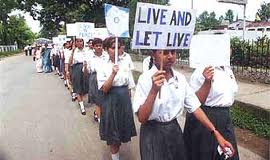A decade back, when I used to contribute news based articles with photographs for various media outlets, I had an astonishing experience. I sent a photograph relating the Independence Day (I-Day) celebration in Guwahati Press Club for a New Delhi based news magazine. At that time, the observation of I-Day (also the Republic Day on January 26) in the insurgency-stricken northeast India was a mere government programme across northeast India under high security covers as the armed militants imposed strict diktats over the celebrations. The people in general of the region avoided the observation mostly because of militants’ threat. So both August 15 and January 26 were assumed as public holidays in the region. Unless on duty, the government officials (not to speak of others) also kept themselves indoors to avoid unwanted situations, as the separatist militants used to enjoy significant influence and support bases at that time.
By Nava J. Thakuria
Naturally, when a group of Guwahati based journalists observed R-Day in 2001 – there were around ten participants – they first hoisted the National flag at Guwahati Press Club and then took out a brief procession on the street. The group had only one Tricolour, carried by senior journalist DN Bezbarua, while marching. Need it be mentioned that the national flag was simply not available in the market during the period.
So, when I sent a photograph of the celebration, a senior editor based in New Delhi responded with irritation, “What is this Thakuria? Hardly seven participating individuals with one flag and that’s also in the background of a curfew like situation…. I am not using it”.
I felt dejected, not because my article was denied space in the news magazine, but experiencing the level of awareness about the socio-political situation in the country possessed by the editor. The great editor had no idea that for decades the people of northeast India were deprived of any community celebrations relating to I-Day and R-Day because of insurgents’ hard-line decrees.
Of course, the situation has improved a lot today. The media fraternity has taken the lead in organizing both I-Day and R-Day defying the militants’ diktat since 1998. The threats from armed outfits still come regularly, but slowly common people start rejecting their orders. The patriotic citizens now-a-days throng in both I-Day and R-Day celebrations organized by the authority and also the communities in various parts of the region.
So it goes this time, when the residents of northeast India joined the celebration of the 68th I-Day on August 15 last with enthusiasm. Defying the militants’ diktat to boycott the national festival, the people joined in the festivity. As usual the auspicious Day was observed by Guwahati based media persons and patriotic people in the local press club, where senior journalist Mukul Kalita unfurled the Tricolour. Later the participating journalist and prominent citizens including Hiten Mahanta, Ranen Kumar Goswami, Sabita Lahkar, Dipen Bayan, Ravi Shankar Ravi, Ajay Dutta, Jagadindra Raichoudhury, Kailash Sharma, Jayanta Gogoi, Pradip Thakuria etc joined in a procession.
Earlier Journalists’ Forum Assam (JFA) urged the citizens of the region to defy separatist militants’ diktat on the celebrations. The scribe’ body argued that every patriotic Indian should observe both I-Day and R-Day to pay their heartiest tributes to the known and unknown martyrs of India’s freedom movement for their supreme sacrifices.
The JFA’s appeal was an instantaneous reaction to the militants’ statements asking the indigenous people not to participate in the I-Day functions as a ‘mark of protest’ against the Union government in New Delhi.
In a joint statement, United Liberation Front of Assom (Independent), Kamatapur Liberation Organization, National Democratic Front of Bodoland (Songbijit faction), National Liberation Front of Twipra, Hynnewtrep National Liberation Council with six Manipur-based armed groups claimed that New Delhi was pursuing a genocide of indigenous peoples in northeast India silently.
They also declared a general strike (public curfew) starting from midnight of August 14 till the evening of August 15 in order to boycott the celebrations. However essential services relating to medical emergency, religious activities and media were exempted from the purview of the general strike.
However JFA president Rupam Barua argues that the National flag does not belong to the government machineries alone, rather it is a priceless property of the billions of devoted Indians. “Many martyrs of Assam including Kanaklata Barua, Mukunda Kakoti, Kushal Konwar, Tilak Deka, Bhogeswari Phukanani, Nidhanu Rajbongshi, Kamala Miri, Lerela Boro, Madan-Rauta, Hemoram Patar, Gunabhi Bordoloi etc laid down their lives for the honour of the Tricolour,” he added.
The north-eastern part of India gives shelter to nearly 20 active and neutralized armed outfits which are waging a war against New Delhi for different demands ranging from sovereignty to self-rule for the indigenous populace. But many outfits now face splitting while some of them start engaging in peace talks with the governments after thousands of their cadres were killed in the counter insurgency operations carried out by the security agencies and also in factional disputes. Thousands also surrendered to the authority to join in with mainstream society.
Losing fast their support-bases in the last few years, the ant-talk factions of the militant outfits still keep on sending rhetorical press statements to make their presence felt. Occasionally they also indulge in violent activities and always survive on the extorted money from the ‘rich and tainted’ residents of the region.
Today, while the threats from the militants are diminishing and the people are not really scared of joining the celebrations of both the auspicious days, I would definitely agree with that version of my senior editor friend if it were true…
Those were the horrible days indeed!










